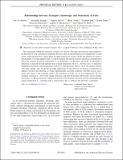Relationship between transport anisotropy and nematicity in FeSe
Abstract
The mechanism behind the nematicity of FeSe is not known. Through elastoresitivity measurements it has been shown to be an electronic instability. However, thus far measurements have extended only to small strains, where the response is linear. Here, we apply large elastic strains to FeSe and perform two types of measurement. (1) Using applied strain to control twinning, the nematic resistive anisotropy at temperatures below the nematic transition temperature Ts is determined. (2) Resistive anisotropy is measured as nematicity is induced through applied strain at fixed temperature above Ts. In both cases, as nematicity strengthens, the resistive anisotropy peaks at about 7%, then decreases. Below ≈40 K, the nematic resistive anisotropy changes sign. We discuss possible implications of this behavior for theories of nematicity. In addition, we report the following. (1) Under experimentally accessible conditions with bulk crystals, stress, rather than strain, is the conjugate field to the nematicity of FeSe. (2) At low temperatures the twin boundary resistance is ∼10% of the sample resistance, and must be properly subtracted to extract intrinsic resistivities. (3) Biaxial in-plane compression increases both in-plane resistivity and the superconducting critical temperature Tc, consistent with a strong role of the yz orbital in the electronic correlations.
Citation
Bartlett , J M , Steppke , A , Hosoi , S , Noad , H , Park , J , Timm , C , Shibauchi , T , Mackenzie , A P & Hicks , C W 2021 , ' Relationship between transport anisotropy and nematicity in FeSe ' , Physical Review X , vol. 11 , no. 2 , 021038 . https://doi.org/10.1103/PhysRevX.11.021038
Publication
Physical Review X
Status
Peer reviewed
ISSN
2160-3308Type
Journal article
Description
We thank the Max Planck Society for financial support. C. W. H., A. P. M., and C. T. acknowledge support by the DFG (DE) through the Collaborative Research Centre SFB 1143 (Projects C09 and A04). C. T. acknowledges support by the DFG (DE) through the Cluster of Excellence on Complexity and Topology in Quantum Matter ct.qmat (EXC 2147). Work in Japan was supported by Grants-in-Aid for Scientific Research (KAKENHI) (No. JP19H00649 and No. JP18H05227), and Grant-in-Aid for Scientific Research on innovative areas “Quantum Liquid Crystals” (No. JP19H05824 and No. JP20H05162) from Japan Society for the Promotion of Science (JSPS).Collections
Items in the St Andrews Research Repository are protected by copyright, with all rights reserved, unless otherwise indicated.

